
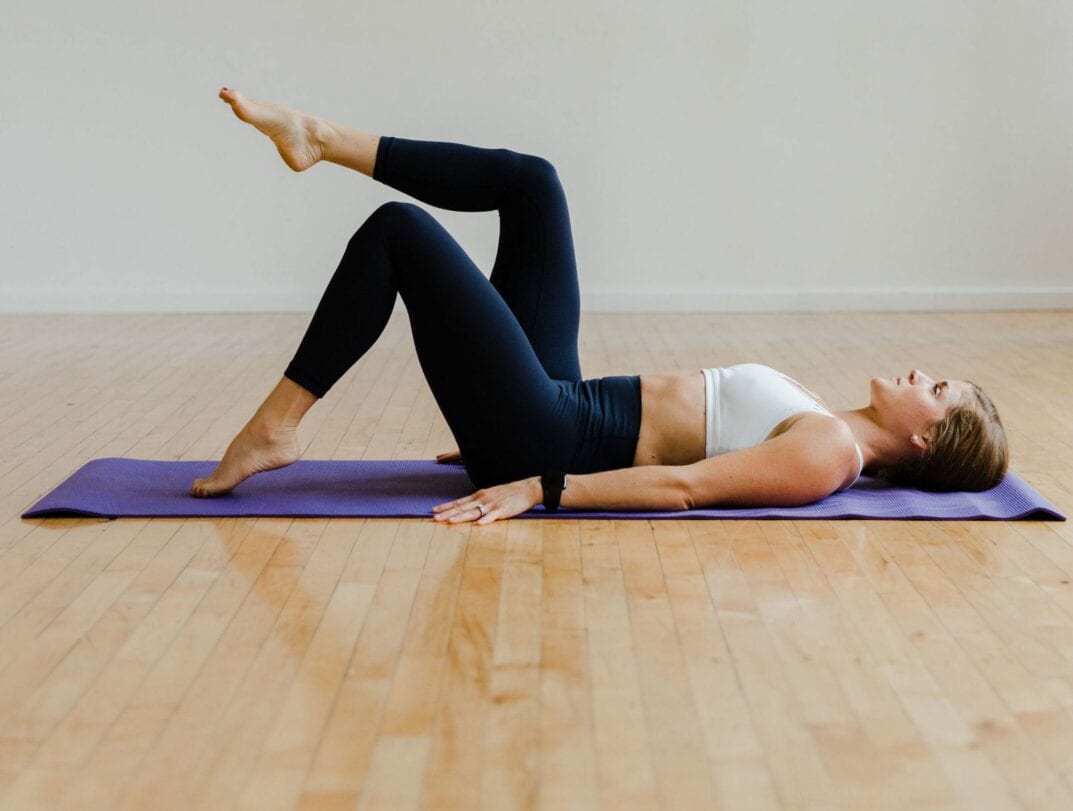
8 BEST Diastasis Recti Exercises (10 Minute Abs After Baby)
Rebuild core and pelvic floor strength and repair diastasis recti (DR) with these 8 diastasis recti exercises. This 10-minute workout targets the transverse abdominals and pelvic floor muscles (which are weakened during pregnancy).
This diastasis recti repair workout is our most popular post on the blog (and has over a million views on YouTube!).
I initially learned about diastasis recti exercises after my first pregnancy. But after three babies and three different post-pregnancy recovery experiences, I’ve learned that there’s a ton of new information out there about how to heal diastasis recti (ab separation) and rebuild core strength post-baby.
We originally filmed this video a few years ago. Since then, we’ve teamed up with my pelvic floor physical therapist (Dr. Sari Abelson PT, DPT) to develop a series of workouts designed to support you along your postpartum recovery journey. While today’s workout is a great place to start, you can find more postpartum workouts and resources here.

10-Minute Abs After Baby
This postnatal ab workout is specifically designed to help you correct diastasis recti, strengthen your core and pelvic floor, and rebuild deep core muscles after pregnancy.
Add this diastasis recti workout to your postpartum workout program as you feel capable, starting with 1-2 times a week and scaling up to 3-4 times a week. I recommend alternating this workout with our other diastasis recti workout videos to avoid workout boredom.
Workout Equipment:
No equipment needed, just your bodyweight.
Workout Instructions:
Follow along with the guided 10-Minute Abs After Baby Workout Video on YouTube, led by certified personal trainer and fitness instructor, Lindsey Bomgren.
Your Workout Looks Like This:
- 8 Diastasis Recti Exercises
- Timed Intervals (perform each exercise for 30 seconds of work)
- Repeat all 8 Exercises x2 Sets
- *Note: Start where you are and do what you can! Maybe you start by performing the first three diastasis recti exercises for 20-30 seconds, rest and repeat. Then slowly add on exercise 4, then 5, and progress your way up to completing all eight diastasis recti exercises.
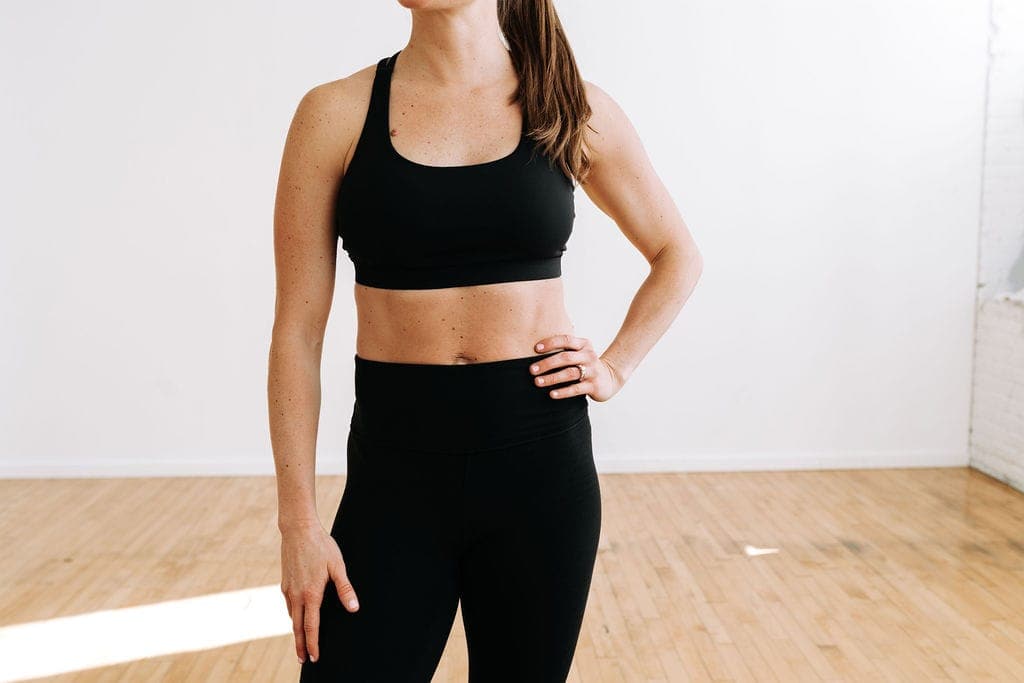
Prefer to Watch On YouTube?
Workout Outline
- Transverse Abdominal Breathing (Core Connection)
- Alternating Heel Slides and Leg Lift
- Lying Bent Knee Pulls
- Elevated Bent Knee March
- Alternating Leg Extension and Leg Drop
- Alternating Leg Kick Out and Two Circles
- Elevated Bent Knee V-Taps
- Elevated First Position Kick Outs
8 Best Exercises for Diastasis Recti
Transverse Abdominal Breathing (Core Connection)
Targets: The deep transverse abdominal muscles (TVA) and pelvic floor muscles. These muscles support your internal organs, your inter-abdominal pressure system, and provide stability and mobility of your lower spine.

How To Do Transverse Abdominal Breathing and Core Connection
- First, activate your transverse abdominis muscles. Lie flat on your back with your knees bent at 90 degrees and feet flat on the floor. Find your hip bones and move your fingers one inch inwards.
- To find your transverse abdominis muscles, fake cough. The muscles you feel ‘pop’ when you cough are your transverse abdominis muscles.
- To engage them, take a deep breath and allow your core and pelvic floor to relax. Imagine there is a string between your hip bones and as you exhale that string (or your TA muscles) is pulling your hip bones together.
- As you inhale, let the belly expand (let your back pop off the ground).
- As you exhale, pull the belly in tight and think about tucking the tailbone underneath you to press your back into the mat or wall.
Alternating Heel Slides and Leg Lift
Targets: Deep transverse abdominal muscles (TVA), lower abs and hips.
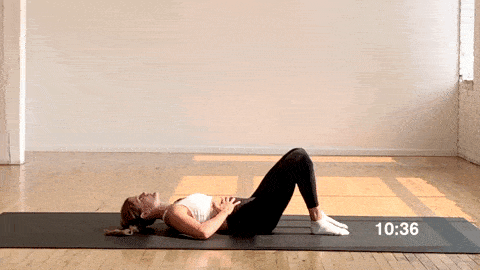
How To Do Alternating Heel Slides and Leg Lift
- Start lying on your back, knees bent and feet planted in front of your glutes. Inhale, letting your belly expand.
- Exhale, pulling your core together and pressing your low back firmly into the mat as you slide your right heel away from your body. Keep your left heel planted on the mat.
- Then, trying to keep your extended leg as straight as possible, raise your leg off the ground to lift it back to the starting position.
- Repeat, this time sliding your left heel away from your body and keeping your right heel planted.
Modification: Take out the leg raise and only perform the heel slides.
Lying Bent Knee Pulls
Targets: Deep transverse abdominal muscles (TVA), lower abs and hips.
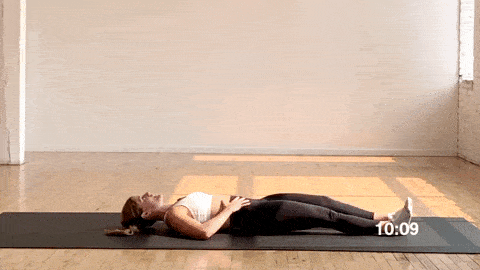
How To Do Lying Bent Knee Pulls
- Start lying flat on the floor, lower back pressed into the mat with feet together and legs extended long. Inhale, letting your belly expand.
- Exhale, pulling your core together and pressing your low back firmly. Option to raise the heels off the mat to intensify this movement.
- Then pull your right knee in to meet your chest, bending the right leg as you do so, feet are flexed and left leg remains straight out.
- Hold the right knee to the chest for a moment, then kick the right leg back out so both legs are kicked straight out again.
- Alternate the knee that pulls in throughout this movement.
Modification: Option to keep both legs on the ground and alternate the knee pull.
Elevated Bent Knee March
Targets: Deep transverse abdominal muscles (TVA), lower abs and hips.

How To Do Elevated Bent Knee March
- With your low back pressing firmly into the mat and your abdominal wall wrapped as tightly as possible around your core, bring your legs to a 90-degree bend.
- Inhale as you lower your right heel to tap the mat, keeping bends in both knees.
- Exhale as you pull your right leg back to starting position. The movement is slow and controlled.
- Repeat with your left heel, tapping the mat and returning to starting position.
Modification: Option to keep both toes on the ground and alternate lifting one knee towards your chest. Keep in mind that the closer your knees are to your chest, the easier this ab exercise will be. The farther your knees are from your chest, the more intense this will be.
Alternating Leg Extension and Leg Drop
Targets: Deep transverse abs, rectus abdominis muscle, lower abs and obliques.

How To Do An Alternating Leg Extension and Leg Drop
- With your low back pressing firmly into the mat and your abdominal wall wrapped as tightly as possible around your core, bring your legs to a 90-degree bend.
- Extend the right leg straight out, then slowly lower the right leg towards the ground.
- With control, pull the right leg back to the starting position and alternate by extending the left leg straight out, then slowly lowering the left leg towards the ground.
- Return to starting position and repeat, keeping your low back pressed into the mat throughout. Remember that this movement is slow and controlled.
Modification: Omit the leg lower and only perform the alternating leg extensions. Note that the closer your knees are to your chest, the easier this ab exercise will be. The farther your knees are from your chest, the more intensity you’ll feel.
Alternating Leg Kick Out and Two Circles
Targets: Transverse abdomen, upper abs, lower abs and hips.
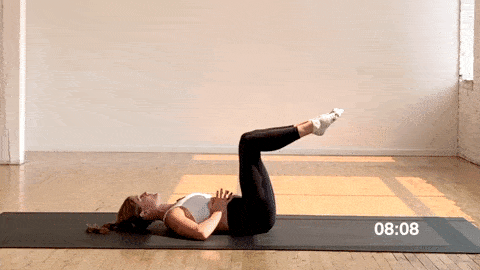
How To Do An Alternating Leg Kick Out and Two Circles
- Start with your low back pressing firmly into the mat and your abdominal wall wrapped as tightly as possibly around your core. Bring your legs to a 90-degree bend.
- Alternate extending one leg straight out, then slowly draw two donut-sized circles with the big toe of your extended leg.
- Return to the starting position, and repeat on the other side. This movement is slow and controlled.
Modification: Option to omit the circles and just perform alternating leg extensions. Note that the closer your knees are to your chest, the easier this ab exercise will be. The farther your knees are from your chest, the more intensity you’ll feel.
Elevated Bent Knee V-Taps
Targets: Deep transverse abdominal muscles (TVA), lower abs, upper abs, hips and pelvic floor.
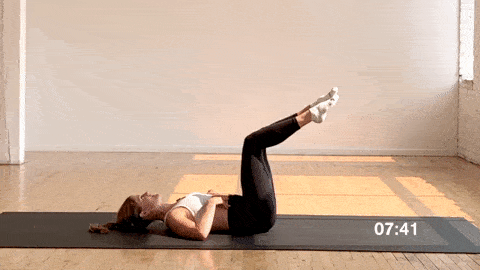
How To Do Elevated Bent Knee V-Taps
- With your low back pressing firmly into the mat and your abdominal wall wrapped as tightly as possible around your core, bring your legs to a 90-degree bend.
- Maintaining the 90-degree bend in your legs, inhale as you lower both feet towards the outside of your mat on a two-count.
- Tap your toes on the outsides of your mat, then return to the starting position on a two-count, squeezing your knees and inner thighs to touch as you return. This movement is slow and controlled.
Modification: Drop only one leg to the outside of the mat and return to the starting position, then alternate by dropping the other leg. Note that the closer your knees are to your chest, the easier this ab exercise will be. The farther your knees are from your chest, the more intensity you’ll feel.
Elevated First Position Kick Outs
Targets: Deep transverse abdominal muscles (TVA), lower abs, upper abs, hips and pelvic floor.

How To Do Elevated First Position Kick Outs
- With your low back pressing firmly into the mat and your abdominal wall wrapped as tightly as possible around your core, bring your legs to a 90-degree bend.
- Bring your feet to first position by bringing the heel to touch. Toes are pointed out, making a ‘V’ with your feet.
- Slowly kick both heels out, away from your body on a two-count. Squeeze your inner thighs to touch as you reach full extension.
- Then return to the starting position on a two-count, pulling your knees back towards your chest at a 90-degree bend. This movement is slow and controlled.
Modification: Kick one leg out at a time, alternating the leg that extends. Note that the closer your knees are to your chest, the easier this ab exercise will be. The farther your knees are from your chest, the more intensity you’ll feel.
Diastasis Recti Exercises FAQs
Diastasis recti occurs when the rectus abdominis muscles (six-pack ab muscles) and linea alba (connective tissue) separate (particularly as your belly grows during pregnancy). This abdominal muscle separation can range from mild to severe. Symptoms of diastasis recti include: low back pain, urinary or bowel problems and poor posture. You might also experience difficulty performing load transfer tasks necessary for bending, reaching, lifting, carrying, squatting, walking, and stair climbing (all the activities that new moms quickly become experts in).
Learn how to check for diastasis recti at home here (I filmed this video with a pelvic floor physical therapist). Sometimes, diastasis recti will heal itself, but other times it may require physical therapy. If it’s an option available to you, I recommend everyone who’s been through a pregnancy see a pelvic floor physical therapist to assess for diastasis recti and more. I’d also recommend checking out this interview: 10 Things You Need to Know About Your Pelvic Floor After Baby!
Every postpartum healing experience is different. Talk to your doctor or midwife for medical clearance before returning to exercise after giving birth, especially if you had any complications. I personally started using these 8 diastasis recti exercises around two weeks post-baby. I started with the first four exercises and progressed up to all eight exercises around 6-8 weeks postpartum. Start where you are and do what you can!
Assessing for hard verse soft doming during exercise is a good gauge to determine how your body is managing pressure. Soft doming is when you can press your tissue inward. Whereas, hard doming is when the dome is firm. You want to avoid hard doming as it’s a sign that your tissue is working to its max capacity. Wondering when it’s ok to return to running and higher intensity strength training? Try this Postpartum Fitness Test.
The American College of Obstetricians and Gynecologists (ACOG) says that postpartum exercise can strengthen abdominal muscles, boost energy, relieve stress, promote better sleep and may help prevent mood swings, postpartum depression and anxiety or the “baby blues”.
More Workouts
Postpartum WorkoutsPin these Diastasis Recti Safe Ab Exercises

This post includes affiliate links. I do earn a commission for products purchased using these links (at no additional cost to you). Thank you for supporting Nourish Move Love, making the content you see on this blog possible.












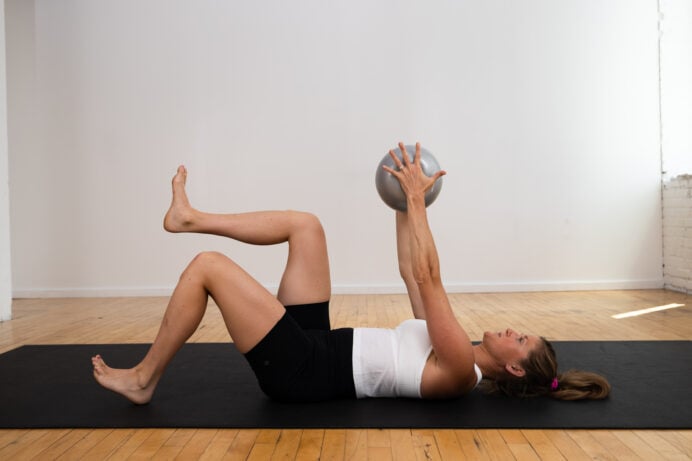



















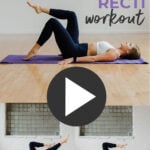


Hi Lindsey! Just wondering how soon after giving birth is it safe to do these exercises?
Hi Emily! Great question, I have to say check with your doctor/midwife on this one as I’m not qualified to give advice. I personally started transverse abdominal breathing around 2-3 weeks PP, and started with the first three exercises outlined here around 4 weeks PP and progressed up to all seven exercises around 12 weeks PP. I hope that helps. Thank you! -Lindsey
Hi Lindsey—I am a pelvic PT working in the Twin Cities. I have been following you on IG and your blog for some time and love it. I am so happy to see the addition of diastisis Recti and pelvic floor recovery exercise. I would love to connect with you as I am trying to find a resource to refer my patients once they “graduate” from my program.
Hi Charet! Thanks so much for this message + reaching out on IG! I’m so glad we were able to connect on IG and I look forward to chatting more soon! Thank you! Lindsey
I am glad for this post and to hear your recommendations! I am a personal trainer and work with postpartum women. Much of the information out there is not helpful but your moves are great. Just remember the breathing techniques to go along with them to decrease pressure on the pelvic floor and the abdominal wall. And if anyone is ever concerned about diastasis recti or pelvic organ prolapse to see a PT specializing in pelvic floor work. Thanks for all you do and your awesome workouts!
Hi Tracy!
Thanks so much for checking out this post! And yes, I feel like I put the cart before the horse a bit with the breathing, but I did a whole series on my IG stories today on TVA breathing to accompany these exercises! It’s all so important as it all works together! Thanks so much for checking out this post! -Lindsey